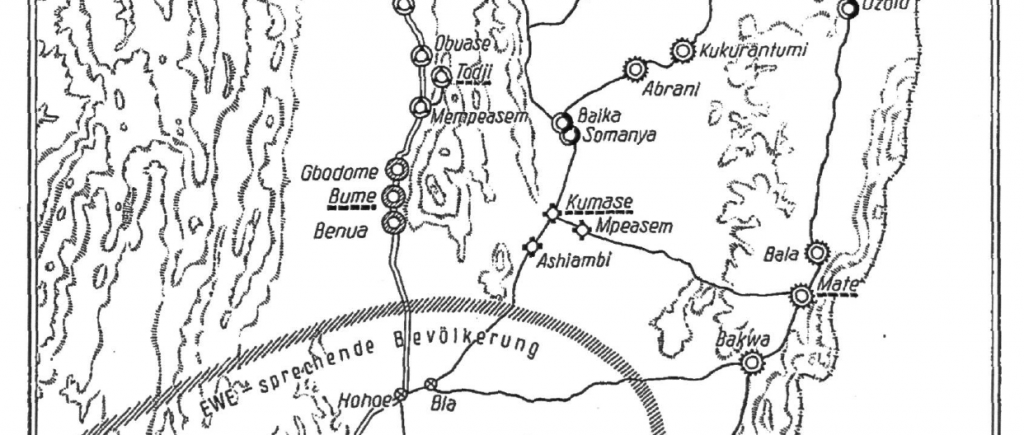Name
There are two stories about the name Santrokofi. According to the first, Santrokofi is a corruption of “Saatelo Kofi” which means our master Kofi. Saatelo Kofi was a constructor of farming and household equipments. Traders from other tribes who used to buy his wares ended up naming the whole traditional area after him as Santrokofi. Another story is that Santrokofi is the name of a bird, a certain kind of nightjar which, if people come close by, suddenly flutters up and alights some distance away. This version, written down by Rudolf Plehn in 1898, is supposed to be an analogy to the migration history of the Balɛɛ, which also happened in abrupt movements from place to place.
Neighbours
The people of Santrokofi have as neighbours, the Akpafu, Likpe, Nkonya, Bowri and Buem. All these tribes occupy a perimeter of about twenty kilometres with a unique Babel of tongues and yet, to an appreciable extent, live in relatively peace and friendship. The advent of the Christian religion and its civilizing influence of “each his brothers keeper “as well as formal education by the use of both principal local and foreign languages had facilitated this commendable socio-economic interaction over the years. Indeed, there must be few places in the world where a few miles introduce one to a new language. We must pause here and pay tribute to an illustrious son of Santrokofi , Teacher Seth K. Akorlor of bless memory who was most instrumental in producing a write-up on the history of the advent of Christian religion in Santrokofi to mark the 75th anniversary celebration of the church in 1978.
History
The Malinese writer Amadou Hampaté Ba once said “in Africa when an old man dies, it’s means a whole library burning”. Thanks to the record put together by Mr. Akorlor, we have found it possible and easier to produce this script. Thus, although he has move on to eternity, the library is still there! There was a school of thought, particularly held by oral historians and Elders from Santrokofi Gbodome that the people of Santrokofi had there origin from a town called “Kombi Sεlεε” which was in ancient Ghana.
Curiously a historical research feature published in the West African magazine in the early 1960s seemed to confirm that claim! We do hope that sooner than later, a son or daughter of Santrokofi will pick up the pieces from where the elders left their trail and establish the fact. The sojourn in the wilderness must have followed that which all the genuine tribes with root from ancient Ghana followed to the present state of Ghana. Some historian ancestors also claim that they up at king Agorkoli’s Notsie but left earlier before the major tribes deserted that kingdom. They settled briefly on the Akporso Mountains situated in Togo and moved to share habitation with the people of Likpe where they developed close linguistic and cultural ties including puberty rites. For reasons yet to be established, they move on from their Likpe brothers to “Okorkpoo” which is on the mountain range west of present Santrokofi Township where they fought and drove the Krobos away. Curiously, they left that locality and move eastwards to settle on the mountain peak they called “Olεεkpoo “. It is from there that they made their final movement to the valley which is the present habitation of the three communities.
German maps show that Santrokofi lands originally stretched to Alavanyo in the south, Akpafu to the north, Nkonya to the west and Lolobi to the east. Their numbers were however reduced drastically as a result of attacks by invading Asante’s forces that carried away both men and women. Some of them however returned later from captivity to re-establish links with their families. The day of the Asante attack remains the subject of the Great Oath of the people of Santrokofi — Balεε Ninkεεh.
The first Missionaries to bring the world to the people at Olɛɛkpoo were from Basel Missionaries led by a Rev. Clerk used to travel on horse back to preach to the people at Olεεkpoo. It was during that time that a German Missionary or government official was said to have arrived at Olεεkpoo and hoisted a German flag probably to indicate an intention to establish an institution there. A man by name, Asasaku who oral historians claimed used to feign madness was said to have removed the flag and used it as a cover cloth. On the next visit of the Germans, when they found that the flag had been removed, they left the Traditional area.
* Source of map: Höftmann, Hildegard, and E. Berger. 1965. “Bericht über ein linguistisch-ethnographisches Forschunsunternehmen in der zentralen Volta-Region der Republik Ghana 1963/4.” Ethnographisch-Archäologische Zeitschrift 6: 140-146.


23 Responses to About Santrokofi